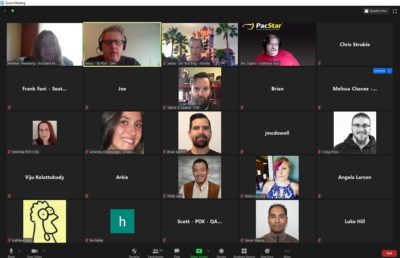Thank you to everyone — host Joe Colantonio, keynotes, technical presenters, workshop leaders, sponsors, volunteers and the board, and attendees — for making this virtual conference happen.
 PNSQC 2020 was three days packed with tips, techniques, and takeaways to improve your software quality. Presenters shared a wealth of knowledge — from helping teams function better, to learning how to adopt new-to-you approaches to testing, to the latest in AI.
PNSQC 2020 was three days packed with tips, techniques, and takeaways to improve your software quality. Presenters shared a wealth of knowledge — from helping teams function better, to learning how to adopt new-to-you approaches to testing, to the latest in AI.
Keynotes
Some highlights included presentations by this year’s keynotes:
- Jason Arbon gave us a new approach to testing by borrowing from DevOps, to create the focus of his presentation, “TestOps.”
- Jenny Bramble explained that testers don’t just test, but communicate the both the good and the bad, in “Test Engineers are the Connectors of Our Teams.”
- Paul Gerrard said in “Rethinking Test Automation” that anti-regression is the primary goal in testing, and that we should be identifying and eliminating unwanted changes.
- Dr. Tafline Ramos showed us that quality is EVERYONE’S job, in her talk, “Quality Engineering – Reflecting on the Past & Present to Accelerate the Future.”
- Raj Subrameyer focused on “Breaking Down Biases and Building Inclusive AI” and stressed the importance of having defined acceptance criteria and evaluation metrics to reduce problems.
 Technical Talks
Technical Talks
While the keynotes looked at big picture changes to the industry, the PNSQC 2020 technical talks showed where we can make incremental changes to software and teams:
- Melissa Tondi emphasized the importance of making requirements more testable in “The New Role of the Agile Tester – The General Contractor.”
- Christian Wiswell tackled a nightmare scenario for testers: Testing a model where the real-world results are unknown, in his talk, “Testing COVID-19 Models: Getting Important Work Done In A Hurry.”
- Iryna Suprun shared lessons learned from using AI testing platforms Testim, Mabl, and TestCraft in “Of Machines and Men.”
- Chris Struble explained how to generate test cases based on software that generates more examples than we can provide in “Generator-Based Testing: A State By State Approach.”
- Anna Sharpe taught the benefits of running tests in production to get more accurate metrics of an application’s performance in “Software Performance and Load Testing Utilizing JMeter.”
- Rob Sabourin and Mónica Wodzislawski have been working to instill testing mindsets in developers for decades, sharing their findings in “Teaching Testing To Programmers: What Sticks, And What Slides Off?”
- Jack McDowell rethinks software standards, taking into account variations in culture in “Towards a Culturally Inclusive Software Quality.”
- Rebecca Long recommended staying open to exploratory testing to meet user needs in “Human Centric User Acceptance Testing.”
- Joel Montvelisky dove into the value testers bring to a company in “Let’s Focus More On Quality Engineering And Less About Testing.”
In case you missed any of the presentations, check your email for links to the entire conference’s presentations. Plus, you can check out the notes that Michael Larsen took while liveblogging the PNSQC 2020 sessions.
 Third Day Stretch
Third Day Stretch
Traditionally, the first two days of PNSQC are for keynotes, technical talks, and poster paper presentations, with long-form workshops all Day 3. We changed this up for 2020.
The PNSQC Program Committee recruited Joe Colantonio to host and moderate the first two days, opening the third day to include a choice of tech talks, a panel discussion, and shorter, free workshops.
As this was PNSQC’s first all-virtual conference, there were many unknowns involved in hosting it. Attending all-day Zoom sessions can be draining, so we tried our best to keep the conference entertaining and engaging. Afterall, our mission is to provide a platform for learning, and PNSQC should be a chance for you to feel invigorated and refreshed.
Creating this hybrid Day 3 also provided more opportunities for technical talks, personal interactions, and letting attendees choose whichever most aligned with their role and interest. Adding lunchtime networking also gave attendees more opportunities to discuss what they learned, what they’re excited to take back to the office, and what questions they now have after watching the presentations.
We’re always open to trying new things, and want to know what you thought of the 2020 schedule. Let the program committee know your thoughts on how this worked for you.
Diversity in Testing
The PNSQC panel “Diversity in Testing and Technology,” undeniably answered whether more diverse perspectives are needed in testing. The answer is “yes!”
Reflecting some of the cultural issues of 2020, this panel was a spirited discussion and represented many viewpoints. Lisette Zounon pointed out that teams need to match the diversity of the users. This includes geographical, gender, and cultural diversity. Hussain Dhanani said educational requirements can be a barrier while Rebecca Long emphasized that we need to also develop new pathways up the career ladder, since traditional routes are sometimes blocked. Raj Subrameyer suggested avoiding mandates while still looking at diversity in hiring. What matters is the path and opportunities for the hires beyond just filling seats.
Let us know if you enjoyed the discussion and thought it was worthwhile for the conference.
2021: Coming Together
The theme for PNSQC 2021 will be Quality Coming Together. This echoes both the hope that we can have a hybrid conference next year — virtual and co-located — and that to provide quality in your software you need many people, skills and moving parts coming together to create a larger system. Consider submitting a talk for next year, and we hope to see you October, 11-13 2021.




